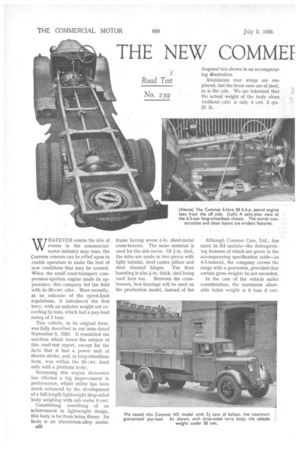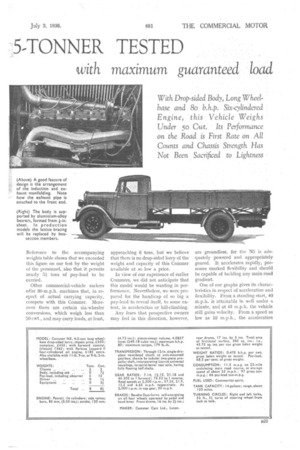THE NEW COMME 5-TONNER TESTED
Page 32

Page 33

Page 34

If you've noticed an error in this article please click here to report it so we can fix it.
WHATEVER course the tide of events in the commercialmotor industry may take, the Commer concern can be relied upon to enable operators to make the best of new conditions that may be created. When the small road-transport compression-ignition engine made its appearance, this company led the field with its 30-cwt. oiler. More recently, as an outcome of the speed-limit regulations, it introduced the first lorry, with an unladen weight not exceeding 2i tons, which had a pay-load rating of 5 tons.
This vehicle, in its original form. was fully described in our issue dated September 6, 1935. It resembled the machine which forms the subject of this road-test report, except for the facts that it had a power unit of shorter stroke, and, in long-wheelbase form, was within the 50-cwt. limit only with a platform body_
Increasing this engine dimension has effected a big improvement in performance, whilst utility has been much enhanced by the development of a full-length lightweight drop-sided body weighing with cab under 8 cwt.
Constituting something of an achievement in lightweight design, this body is far from being flimsy. Its basis is an aluminium-alloy under
22 frame having seven i-in. sheet-metal cross-bearers. The same material is used for the side raves. Of 1-in, deal, the sides are made in two pieces with light tubular, steel centre pillars and steel channel hinges. The floor boarding is also Fin. thick, deal being used here too. Between the crossbearers, box-bracings will be used on the production model, instead of the diagonal ties shown in an accompanying iklustration.
Aluminium rear wings are employed, but the front ones are of steel, as is the cab. We• are informed that the actual weight of the body alone (without cab) is only 4 cwt. 3 qrs. 25 lb.
Although Commer Cars, Ltd., has rated its N5 models—the distinguish• ing features of which are given in the accompanying specification table—as 4-5-tanners, the company covers the range with a guarantee, provided that certain gross weights be not exceeded.
In the case of the vehicle under consideration, the maximum allowable laden weight is 8 tons 6 cwt. Reference to the accompanying weights table shows that we exceeded this figure on our test by the weight of the personnel, also that it permits nearly 5i tons of pay-load to be carried.
Other commercial-vehicle makers offer 30-m.p.h. machines that, in respect of actual carrying capacity, compete with this Commer. Moreover there are certain six-wheeler conversions, which weigh less than 50 cwt., and may carry loads, at least, approaching 6 tons, but we believe that there is no drop-sided lorry of the weight and capacity of this Commer available at so low a price. In view of our experience of earlier Commers, we did not anticipate that this model would be wanting in performance. Nevertheless, we were prepared for the handicap of so big a pay-load to reveal itself, to some extent, in acceleration or hill-climbing. . Any fears that prospective owners may feel in this direction, however, are groundless, for the N5 is adequately powered and appropriately geared. It accelerates rapidly, possesses marked flexibility and should be capable of tackling any main-road gradient.
One of our graphs gives its characteristics in respect of acceleration and flexibility. From a standing start, 40 m.p.h. is attainable in well under a minute, and at 45 m.p.h. the vehicle still gains velocity. From a speed as low as 10 m.p.h., the acceleration
curve rises almost as steeply as it does higher up the scale. Under normal conditions, a rather longer paiise, than is indicated on the graph, is necessary, in each case, to make a silent gear change.
Between Hitchin and Luton, travelling towards the latter town, there is a gradient incorporating about 350 yds. of 1 in 84, known as Offiey Hill. It is approached by a more gradual climb, terminating in a bend, so cannot be "rushed." The Cornmer covered the fifth-of-a-mile in 2 minutes, using first gear for the biggest part of it.
At the summit the temperature of the cooling water was only 190 degrees . F., despite an atmospheric temperature of about 80 degrees F. Second gear was found to be too high for this hill, but not by much.
After making the non-stop ascent, we ran down
again, and reAS climbed the hill, 4o this time pausing on the steep section to test the hand brake, and to assure ourselves that the machine could make a clean getaway up this gradient.
Points revealed were that the hand brake holds with complete security and that it can be operated under such conditions with ease, whilst, judging by the absence of any sort of difficulty in accomplishing the restart on Offiey, we are confident that no hesitation would need to be felt about performing a similar operation on a much steeper acclivity.
A feature of this hand-brake lever is that it applies the same four sets of shoes as the pedal, and as the shoes are of the self-energizing type, exerts a retardation that is only slightly inferior to that effected by the foot.
This fact is revealed unmistakably by the accompanying braking curves. Indeed, the difference is actually less than shown, for during the course of our braking tests, the • sun heat, which that day was particularly intense, softened the tarmac, and the last few readings we took were higher than would otherwise have been the case through sliding of the wheels.
The Bendix brakes are highly efficient, and behave, in their latest form, with consistency. The only criticism, we have to make is that initial application, if at all vigorous and particularly at the lower speeds, causes momentarily a jerk of some
violence. Under normal driving conditions this would probably occur only in an emergency.
For our consumption test we twice exhausted a one-gallon test tank. Starting from the foot of Offiey Hill, we ran down to Hitchin, and proceeded along the Bedford road, the first gallon carrying us 11.9 miles. We then replenished the tank, proceeded to Dead Man's Cross, about 4-mile farther on, turned and retraced our tracks.
The turning point is on high ground, so that the downward slope at the beginning was partly compensated by the ascent at the end of the outward run. On the return, the
gallon was consumed in 11.1 miles. Thus, we did not quite reach the starting point. On the other hand, at the end of the day, in checking the test-tank capacity, we found it to be slightly under measure. The average figure quoted, namely 11.5 m.p.g., should be a fairly accurate basis for
calculation, given easy conditions. '
From the driver's point of view, the Commer 4-5-tonner is highly roadworthy and easy to handle. A point we have raised on previous occasions in connection with Commer products, is the lowness of the reverse ratio.. It is certainly an asset, in certain circumstances, to be able easily to move backwards inch by inch, but time is more often of importance.
The suspension is good, quite deep pot-holes causing surprisingly little shock to the machine.
Equipment is comprehensive, and the cab has a windscreen that can be opened to a nearly horizontal position. On the normal-control machine there is room, without marked discomfort, for two passengers.
We understand that considerable' success has already been encountered' by this model, and in our view it is" likely to raise the Commer reputation even higher than it is now.
Whilst obviously an attractive proposition to the general -operator, it should also make a strong appeal to the agriculturist, for he frequently feels the need for a vehicle of greater capacity than the 2-3-tonner, which is generally regarded as the type moSt suited for farm work. This machine. is its equal in so far as the speed-limit is concerned, and, in terms of pay-. load ton-m.p.g., would probably work out as its superior.




















































































